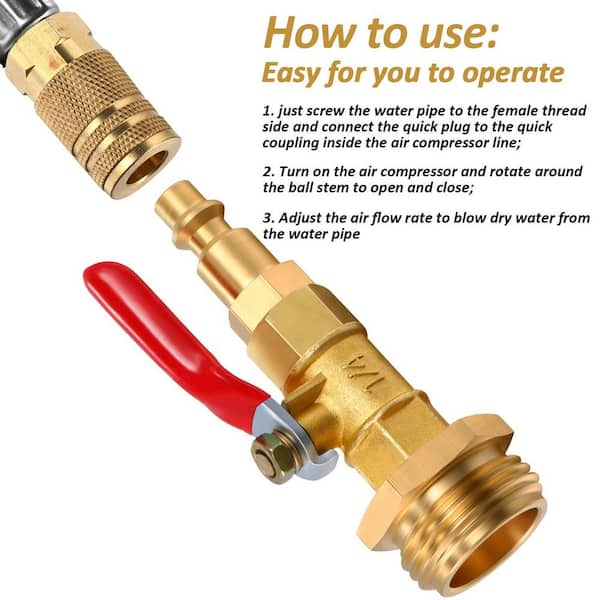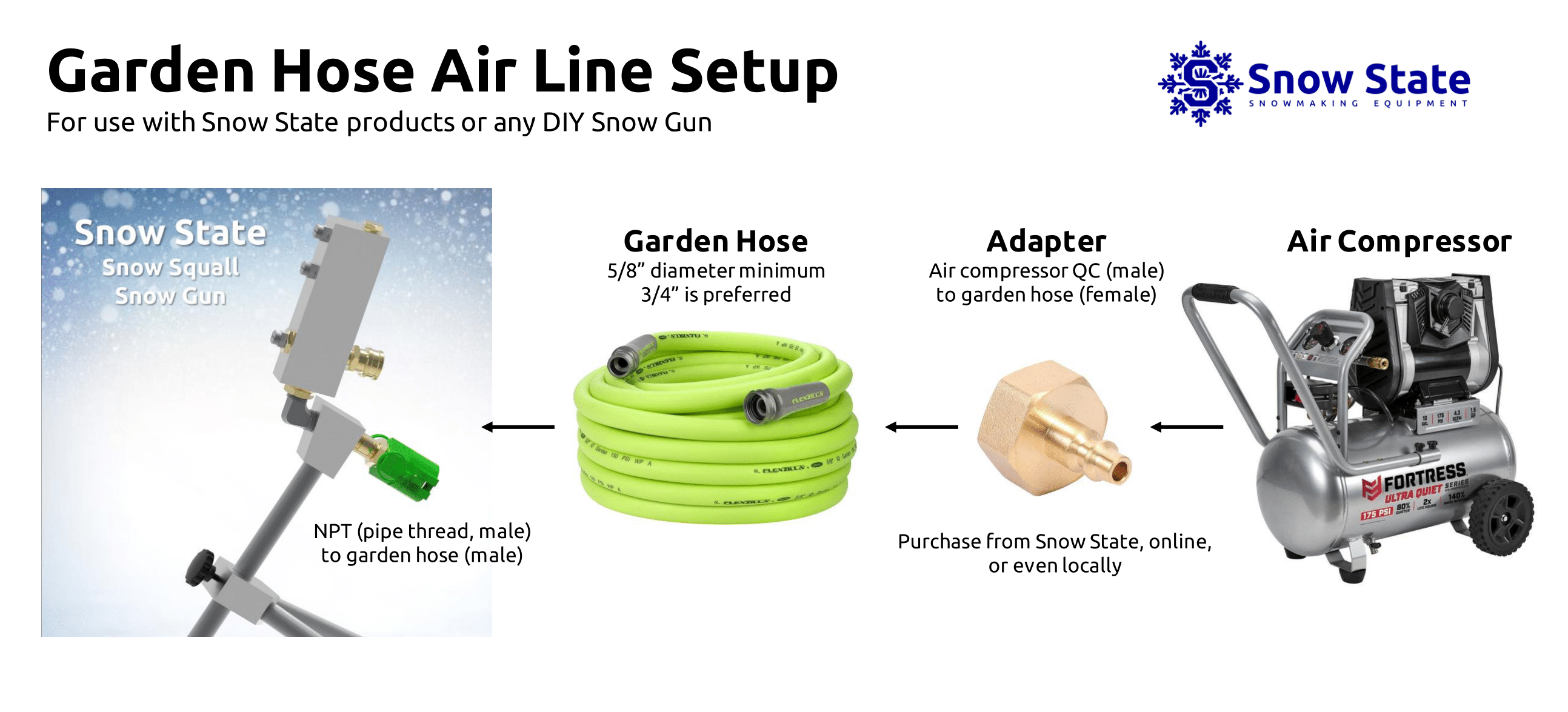Are you struggling to connect your air compressor to a hose that doesn’t quite fit? You’re not alone.
Finding the right air compressor to hose adapter can make all the difference in how smoothly your tools work. Imagine saving time, avoiding leaks, and getting the perfect fit every single time. You’ll discover exactly how to choose the best adapter for your needs and why it matters more than you think.
Keep reading—your next project just got a whole lot easier.

Credit: www.homedepot.com
Types Of Air Compressor Adapters
Air compressor adapters connect hoses to compressors or tools. They come in different types. Each type fits specific needs and hose styles. Choosing the right adapter ensures a tight, leak-free connection. Here are the main types of air compressor to hose adapters.
Threaded Adapters
Threaded adapters use screw threads to connect parts. They provide a strong and secure fit. These adapters come in various thread sizes and types. Common thread standards include NPT (National Pipe Thread) and BSP (British Standard Pipe). Threaded adapters work well for permanent or semi-permanent setups.
Quick Connect Couplers
Quick connect couplers allow fast hose attachment and removal. They snap together without tools. These adapters save time during tool changes. Couplers include plug and socket parts that lock tightly. They often have a push-to-connect design for easy use. Quick connect couplers suit frequent or mobile air tool use.
Barbed Hose Adapters
Barbed hose adapters have ridges or barbs that grip inside a hose. Users slide the hose over the barbs. Clamps secure the connection and prevent leaks. This type fits flexible hoses well. Barbed adapters are simple and cost-effective. They work best with rubber or PVC air hoses.

Credit: snow-state.com
Choosing The Right Adapter Size
Choosing the right adapter size is key for a smooth air compressor setup. A poor fit can cause leaks or damage. It is important to pick an adapter that matches both your hose and compressor fittings. This section explains how to measure and select the correct size for your needs.
Measuring Hose Diameter
First, measure the outer diameter of your air hose. Use a ruler or caliper for accuracy. Measure across the widest part of the hose. Write down the number in inches or millimeters. This size helps find an adapter that fits snugly over the hose end.
Matching Compressor Fittings
Next, check the fitting on your air compressor. Look at the threads or quick-connect design. Identify the size and type of the fitting. Match the adapter’s inner diameter and connection type to the compressor’s fitting. This ensures a secure and leak-free connection.
Common Size Standards
Adapters and fittings follow common size standards. The most popular sizes include 1/4 inch, 3/8 inch, and 1/2 inch. Thread types like NPT (National Pipe Thread) are widely used. Knowing these standards helps find adapters that fit most hoses and compressors easily.
Materials And Durability
Choosing the right materials affects an air compressor to hose adapter’s durability and performance. Some materials last longer and handle pressure better. This section covers common materials and their strength.
Brass Vs Steel
Brass is popular for air compressor adapters. It resists corrosion and handles high pressure well. Brass is softer than steel but still strong enough for most jobs.
Steel is tougher and more durable than brass. It works well in heavy-duty tasks. Steel can rust if not treated, but it is very strong and lasts long.
Plastic Options
Plastic adapters are lightweight and cheaper than metal ones. They work well for light tasks and low pressure. Plastic is not as durable and can crack or wear out faster.
Plastic adapters are easy to handle but not best for heavy use. Choose plastic if you want a budget-friendly, short-term solution.
Corrosion Resistance
Corrosion damages adapters and causes leaks. Brass naturally resists rust, making it ideal for moist environments. Steel needs coatings to prevent corrosion.
Plastic does not rust but can degrade from sunlight or chemicals. Corrosion resistance increases the adapter’s lifespan and keeps connections tight.
Installation Tips For Secure Connections
Secure connections between an air compressor and hose adapter keep your tools working well. Proper installation stops leaks and saves air pressure. Follow these tips for safe, tight fittings.
Preparing Hose Ends
Cut the hose end straight and clean. Remove any dirt or old tape. Check the hose for cracks or damage. A smooth, clean end fits better and seals tightly.
Using Thread Seal Tape
Wrap thread seal tape around the adapter threads. Wrap it clockwise to match the thread direction. Two to three layers of tape prevent air leaks. Press the tape down to avoid bunching.
Tightening Techniques
Hand-tighten the adapter first. Use a wrench for a firm fit, but avoid over-tightening. Too much force can damage threads or hose. Tighten until snug and secure, then test for leaks.
Maintaining Air Compressor Hoses And Adapters
Maintaining air compressor hoses and adapters is key to safe and efficient operation. Proper care extends the life of your equipment. It also prevents leaks and pressure drops. Regular checks and cleaning keep everything working smoothly. Simple steps help avoid costly repairs and downtime.
Regular Inspection
Check hoses and adapters before each use. Look for cracks, cuts, or signs of wear. Inspect connections for tightness and leaks. Replace any damaged parts immediately. Early detection stops bigger problems later.
Cleaning Procedures
Clean hoses and adapters after use to remove dirt and moisture. Use a dry cloth to wipe the surfaces. Avoid harsh chemicals that can damage rubber or metal. Keep the inside clear to maintain airflow. Proper cleaning prevents blockages and corrosion.
Replacing Worn Components
Replace hoses and adapters when signs of wear appear. Old or cracked parts can cause leaks or bursts. Use parts made for your specific air compressor model. Regular replacement keeps your system safe and efficient. Don’t wait until failure to change parts.
Troubleshooting Common Connection Issues
Connecting an air compressor to a hose adapter is simple most of the time. Still, some common issues may stop the setup from working well. Troubleshooting these problems helps keep your tools running smoothly. Below are frequent connection problems and easy ways to fix them.
Air Leaks
Air leaks often cause loss of pressure and reduce tool power. Check the adapter and hose for cracks or holes. Tighten all connections firmly but avoid over-tightening. Use thread tape on the threads to seal gaps. Replace damaged parts to stop leaks completely.
Adapter Compatibility Problems
Not all adapters fit every hose or compressor. Different sizes and thread types cause poor connections. Match the adapter size to your hose and compressor fittings. Look for labels or manuals to find the right type. Using the wrong adapter leads to leaks or no airflow.
Pressure Loss
Pressure loss lowers tool performance and slows work. It may come from long or narrow hoses that reduce airflow. Check for blockages inside the hose or adapter. Keep hoses short and wide for better pressure. Replace old or worn hoses to improve air flow.
Upgrading For Better Performance
Upgrading your air compressor to hose adapter can improve tool performance and efficiency. The right adapter ensures steady air flow and reduces leaks. A good upgrade saves time and effort on every job.
High-flow Adapters
High-flow adapters allow more air to pass through quickly. They help tools run at full power without pressure drops. These adapters suit heavy-duty tasks and long hose runs. Using high-flow adapters reduces tool lag and boosts productivity.
Swivel Connectors
Swivel connectors rotate to prevent hose twisting and tangling. They increase flexibility and ease of movement. Swivel connectors extend hose life by reducing wear and tear. These connectors make handling tools easier and safer.
Custom Adapter Solutions
Custom adapters fit unique setups or unusual hose sizes. They ensure a tight seal and perfect connection. Custom solutions avoid air leaks and compatibility issues. Tailored adapters support specialized tools and improve overall system reliability.

Credit: www.amazon.com
Frequently Asked Questions
What Is An Air Compressor To Hose Adapter?
An air compressor to hose adapter connects the compressor to various air hoses. It ensures a secure, leak-proof fit. This adapter allows compatibility between different hose sizes and types. It improves efficiency and safety during air tool operations.
How Do I Choose The Right Adapter Size?
Select an adapter matching your compressor and hose fitting sizes. Check thread type and diameter carefully. Ensure compatibility for optimal air flow and pressure. Using the wrong size can cause leaks or damage. Always consult your air compressor’s manual for guidance.
Can I Use Any Hose With The Adapter?
No, the hose must match the adapter’s connection type and size. Using incompatible hoses causes leaks and pressure loss. Always verify hose diameter and thread compatibility before connecting. Proper matching ensures efficient and safe air tool performance.
Are Air Compressor Hose Adapters Reusable?
Yes, most air compressor hose adapters are reusable. They are designed for multiple connections and disconnections. Ensure the adapter is undamaged and clean before reuse. Proper maintenance extends the adapter’s lifespan and maintains seal integrity. Always store adapters in a dry place.
Conclusion
Choosing the right air compressor to hose adapter saves time and effort. It ensures a secure and tight fit for your tools. This small part plays a big role in your work. Quality adapters prevent leaks and keep air pressure steady.
Always check size and material before buying. A good adapter helps your compressor work at its best. Simple, reliable connections make any job easier and faster. Keep your tools ready with the right adapter today.

